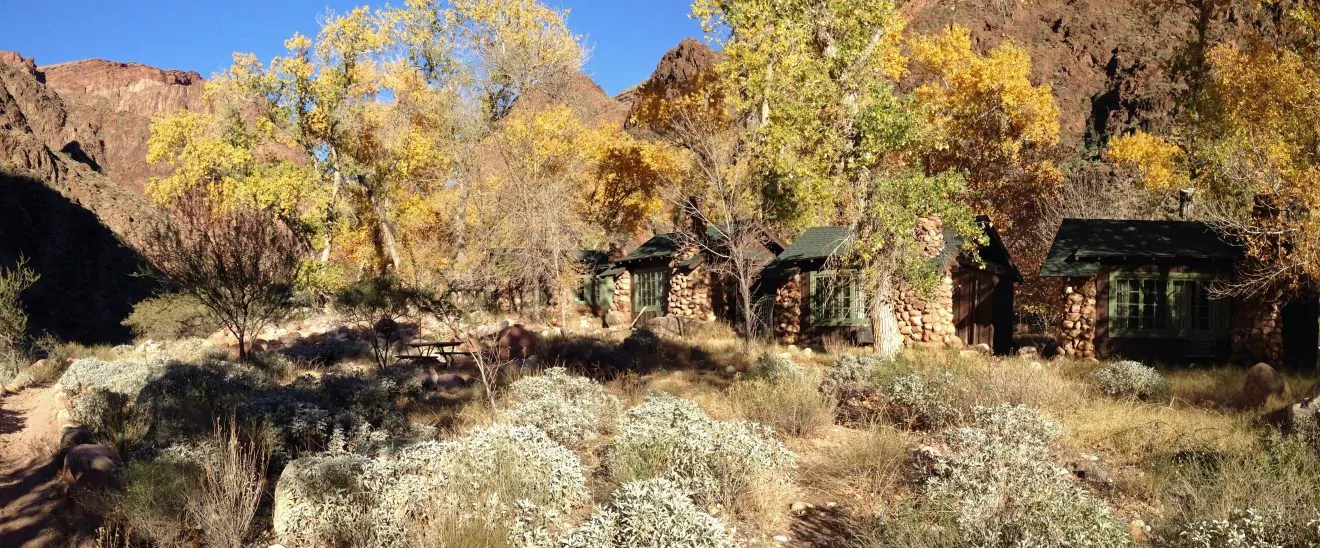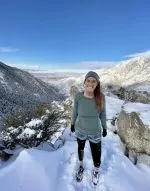Backpacking Rim-to-Rim-to-Rim in the Grand Canyon: Everything You Need to Know
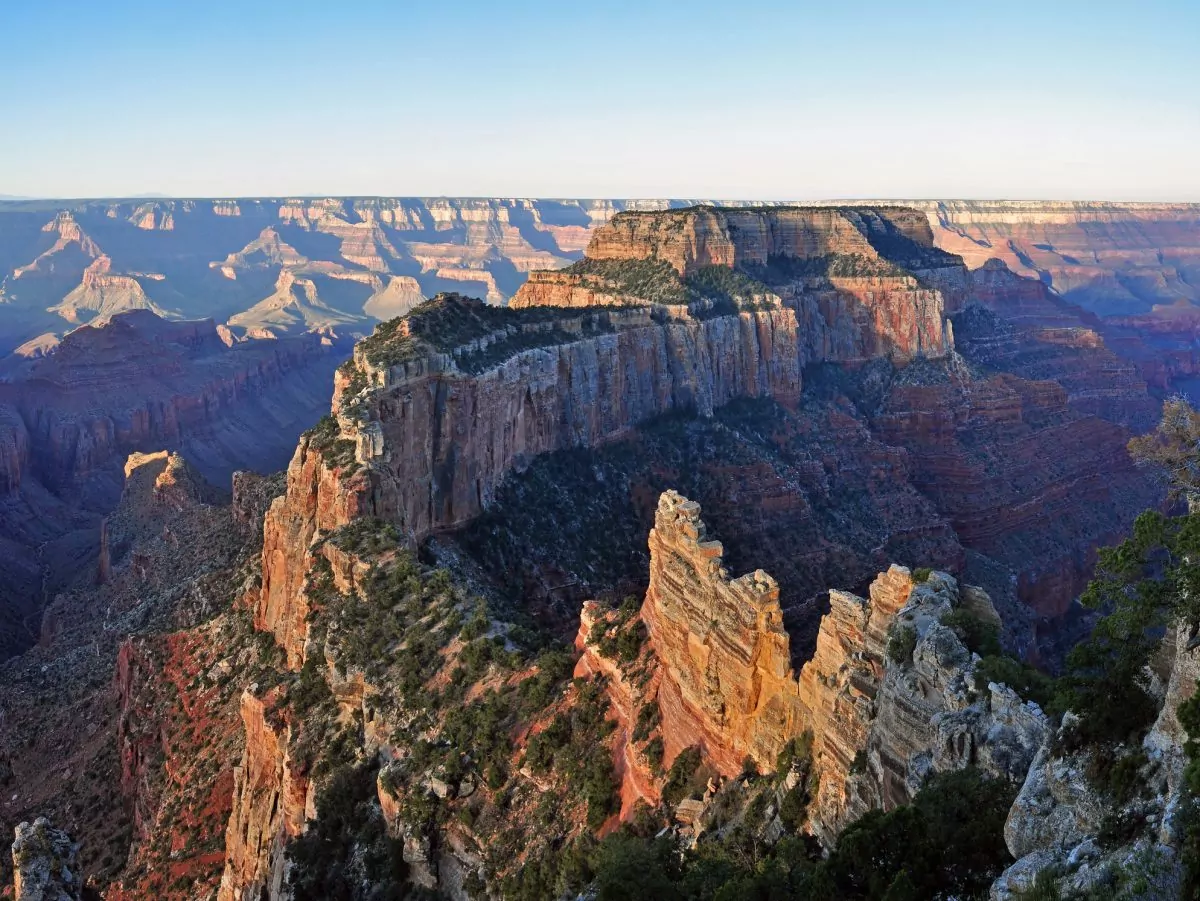
Exhausted, shivering, and barely moving, we trudged back up the Bright Angel Trail. My first time hiking the Rim-to-Rim- to-Rim (R2R2R) in the Grand Canyon was in December 2018. It was my second backpacking trip ever, and we were unprepared for both the cold and the physical exertion. My mind still flashes back to the 4,000-foot climb back up to the South Rim, where every step required extreme mental focus. Though the challenge and sore legs are burned into my memory, I still look back on this trip fondly. The climb was seemingly interminable, but once we got to the top, the trailhead felt completely different and I experienced a kind of physical euphoria I had never felt before. Viewing the orange and red layered canyon walls after hiking through the canyon and back again is truly unforgettable.
I’ve backpacked/ran the Rim-to-Rim- to-Rim route three times now, and am considering going back again this spring. The Grand Canyon is one of the most unique places I have ever been, and each trip left a lasting impression on me. It’s also where I experienced my proudest moment ever: collapsing on top of the South Rim after running R2R2R in one day for my 24th birthday. Recalling the moment brings tears to my eyes, as I remember how the stunning, challenging, harsh, and beautiful landscape has changed me.
BACKPACK the Grand Canyon with Award Winning Guides
Why Hike the Rim-to-Rim- to-Rim?
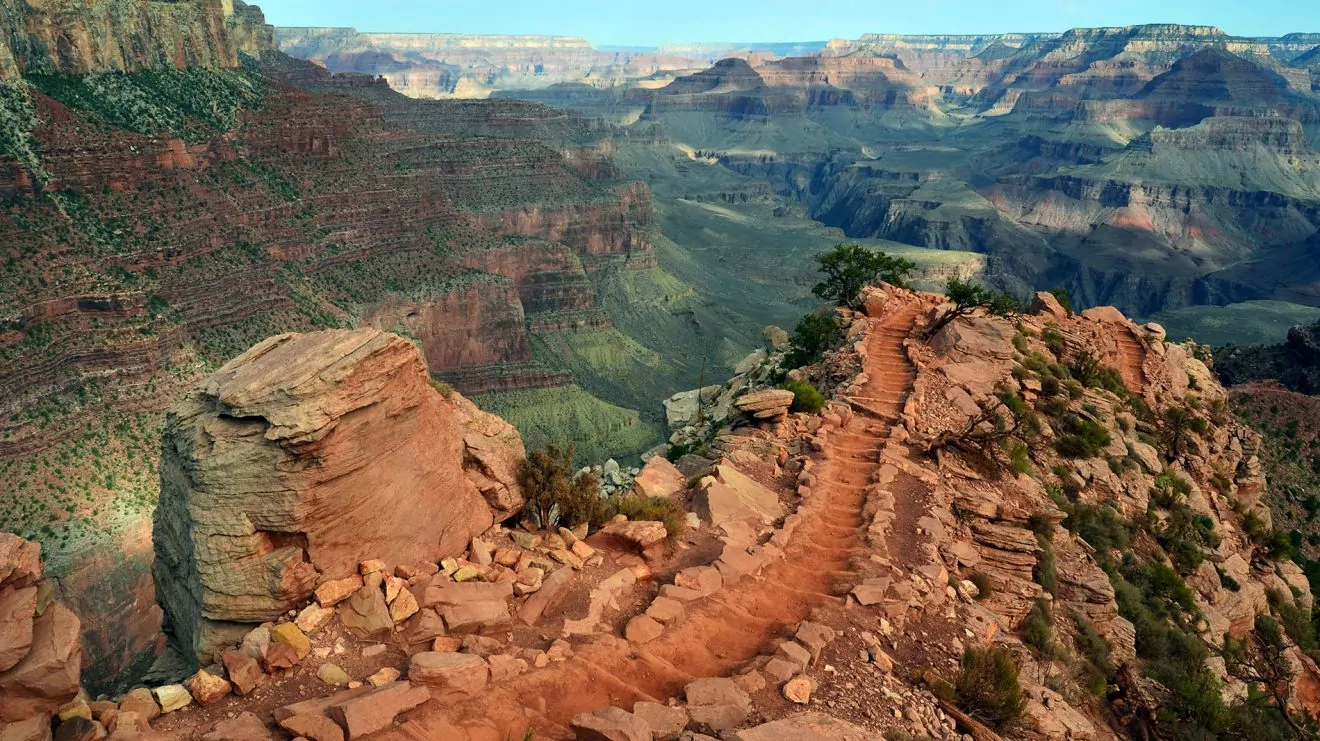
The Grand Canyon is unlike anywhere else in the world. It’s inspired countless adventurers, poets, musicians, and travelers. Trekking by foot from the South Rim to the North Rim is one of the most striking ways to experience the majesty of the canyon, as its ecosystems and geology change with your elevation.
Though I usually don’t prefer out and back trails, it’s worth it for the R2R2R. There’s so much to see with every step; you’ll probably be even more enamored with the landscape on the second crossing. Plus, you can switch it up by choosing different south rim trails. For example, if you start on the South Kaibab, you’ll get expansive views of each layer of the canyon as you descend. On your way back up, hit the Bright Angel Trail for sparkling streams and lush riparian areas where you can find shade under cottonwood trees.
But you may be wondering about crowds on the trail because the Grand Canyon is one of the most popular national parks. Lucky for hikers, permits are strictly enforced in the Rim-to-Rim- to-Rim corridor. For me, I found this to be a happy medium of people on the trail. You’ll encounter enough backpackers to feel safe and have community camaraderie, but the trails are empty enough towards the bottom that you won’t feel overcrowded. Even in one of the world’s top hiking destinations, I’ve hiked for hours without seeing another person.
Though you can day-hike into the canyon from either of the rims, the Colorado River at the bottom of the canyon is one of my favorite places on this earth. One particularly memorable stretch is the seven miles between Phantom Ranch and Cottonwood Campground. It’s relatively flat and winds along the river, flanked by towering canyon walls. I’ve hiked that stretch of trail six times now, and would do it every single day if I could.
Most people hike the Rim-to-Rim- to-Rim as part of a multi-day trek, while some undertake it as an ultra-run. Others hike from the South Rim down to the river and back in a day. While you can reach the Colorado River on an extremely long day-hike, you’ll have little time to soak in the experience and views.
What to Expect
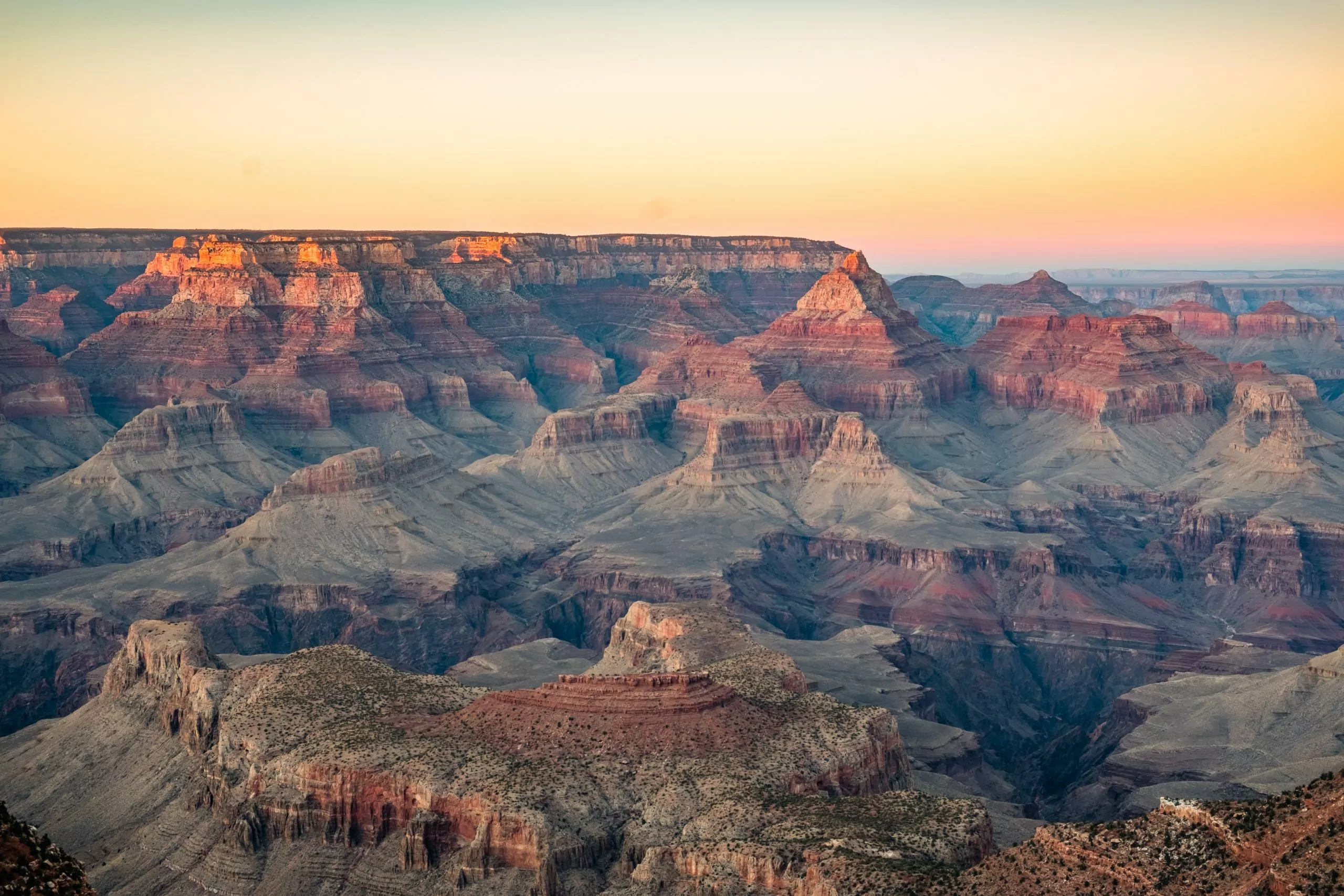
Whether you’re hiking R2R2R solo or with a group, you can expect the full out and back to take 3-5 days. There are many different itineraries possible, so going with a guide service is a great way to take the planning off your plate. Just be sure that your fitness level matches the trip pace. This is an extremely difficult backpacking trip with over 10,000 feet of elevation gain and loss.
One classic version of the Rim-to-Rim- to-Rim trek starts and ends at the South Rim o the South Kaibab Trail, continues to the North Rim, and then returns to the South Rim on the Bright Angel Trailhead. However, many trip itineraries are possible depending on your permit length and campsites.
South Kaibab Trail to Phantom Ranch
Distance: 6.3 miles
Elevation loss: 4,860 feet
The South Kaibab Trail is one of the most direct ways to access the Colorado River, as it features almost 5k of loss in six miles! This steep trail offers up mesmerizing views of the Grand Canyon, and you’ll encounter plenty of resting points along the way – from Cedar Ridge, to Skeleton Point, to the Tip Off. Stop and rest in the shade if you need before continuing down into the jagged layer of Vishnu Schist at the bottom of the canyon.
Phantom Ranch to Cottonwood Campground
Distance: 7.2 miles
Elevation Gain: 2,300 feet
This is the relatively “flat” section of the trail. The first five miles have a gradual incline that you hardly notice; most of the elevation gain is in the last couple of miles. In the early morning or late afternoon, this section is mostly shaded by the canyon walls with a nice breeze coming off the river.
Cottonwood Campground to North Kaibab Trailhead
Distance: 6.8 miles
Elevation Gain: 4,080 feet
The climb up to the North Rim is harder than the South Rim. The trail gets steeper as you get higher, and it’s seemingly never-ending. However, the views of the canyon and waterfalls below are absolutely stunning. The terrain gradually turns into pine trees and a darker red rock. On top of the North Rim, it’s breathtaking to see how much the earth can change over just 20 miles of hiking.
Phantom Ranch to Havasupai Garden
Distance: 5.5 miles
Elevation GaiN: 1,400 feet
Once you return to the bottom of the Grand Canyon from the North Rim, you’ll follow the Colorado River again towards the Bright Angel Trail. Enjoy the gradual path along the river and across the historic Silver Bridge before you begin your climb back up. Once you start climbing, you’ll follow side canyons and streams towards Havasupai Garden. This section offers diverse views and plant life, with steep climbs interspersed with more rolling terrain.
Havasupai Garden Campground to Bright Angel Campground
Distance: 4.5 miles
Elevation Gain: 3000 feet
Fill up your water at Havasupai Garden and prepare yourself for a winding climb to the top of the canyon. The trail is seemingly endless switchbacks, with incredible views of canyon walls as far as the eye can see. For primo views, aim to hike this section around sunset.
Know Before You Go
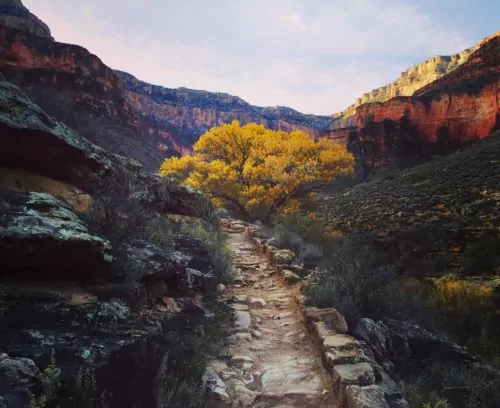
Weather in the Grand Canyon
If you’re hiking during the high season, plan for heat. The bottom of the canyon can be over 20 degrees hotter than the top, so even if it’s nice and breezy at the South Rim, the canyon bottom can reach scorching temperatures. When you’re checking the forecast, make sure to look at both the South Rim (Grand Canyon Village) and Phantom Ranch.
Though temperatures are harsher during peak visiting months, there are more services, like water pumps, available. I recommend going in either of the shoulder seasons –April/May or September/October. I’ve hiked it during September, April, and December, and late September was by far the most favorable weather.
However, winter is also a wonderful time to experience the Grand Canyon. Although you may encounter snow and ice on the trails (bring microspikes!), daytime temperatures are usually pleasant and crowds are fewer.
water Sources
There is plenty of water available via pumps and natural water along the Rim-to-Rim- to-Rim corridor. If you’re hiking during the high season (May – October), the pumps will most likely be turned on. However, be sure to check the National Park Service website for trail and water conditions and always bring a backup filter just in case.
Logistics
One great thing about an out-and-back hike is the lack of travel logistics. Both the north and south rim have multi-day parking for backpackers. The South Rim is typically a bit busier with tourists, but also offers more dining options.
what to bring
Unless you’re staying at one of the highly coveted Phantom Ranch cabins, you’ll need a full backpacking setup. This means a tent, sleeping bag, sleeping pad, and cooking system. You’ll want to dress and pack for temperature swings, especially if you’re going in the shoulder season months. Most importantly, be prepared for sun exposure with UPF protective clothing and plenty of sunscreen.
Guided or Independent?
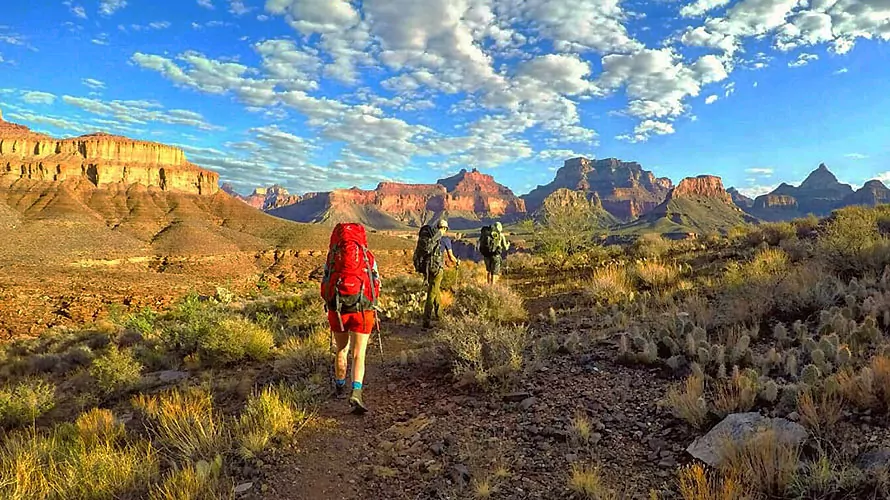 The logistics of this trip are fairly challenging. Securing a permit is difficult, and the walk-up process requires flexibility. Especially if it’s your first time visiting the Grand Canyon, choosing a guided trip takes so much ease off the logistical planning and provides you with full lists of everything you will need. Wildland Trekking offers a Winter Rim-to-Rim-to-Rim backpacking trip where you’ll experience the grandeur of the canyon under a light dusting of snow. We also run Rim to Rim backpacking trips in summer and autumn. Explore all of Wildland Trekking’s backpacking trips in the Grand Canyon here.
The logistics of this trip are fairly challenging. Securing a permit is difficult, and the walk-up process requires flexibility. Especially if it’s your first time visiting the Grand Canyon, choosing a guided trip takes so much ease off the logistical planning and provides you with full lists of everything you will need. Wildland Trekking offers a Winter Rim-to-Rim-to-Rim backpacking trip where you’ll experience the grandeur of the canyon under a light dusting of snow. We also run Rim to Rim backpacking trips in summer and autumn. Explore all of Wildland Trekking’s backpacking trips in the Grand Canyon here.
Grand Canyon National Park is popular for a reason. Backpacking through the Rim to Rim corridor is one of the most memorable ways to experience this magical place. I’ve done this trip three times now, and each time I’ve emerged humbled, grateful, and teary-eyed. Though it’s physically challenging and the permit process is tricky, it’s a bucket list trip that will leave you wanting even more.



